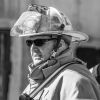As our country responds to COVID-19, public safety agencies are adjusting day-to-day operations to reduce the risk of exposure and help protect personnel.
Volunteer firefighters represent the largest segment of the American fire service but face unique challenges to deal with COVID-19 because they respond from home or work. The risk for cross-contamination between firefighters and their families is therefore heightened and very real.
This article will focus on some commonsense steps volunteer firefighters can take to help reduce the risk of exposure, cross-contamination to personal vehicles and homes, and the greater spread of the virus in general. This article will focus on three important considerations:
- Limit personnel exposure during a response to medical emergencies where patients present signs and symptoms of COVID-19 or other illness.
- Apparatus and personnel decontamination at the fire station.
- Personal decontamination at home.
This is not intended to be an encompassing resource to manage all considerations and risks associated with COVID-19 and other communicable disease threats. It’s rather intended as the first step if your agency currently doesn’t have any guidance in place. The information presented should help to reduce this threat until your organization develops a policy and procedure.
As a general philosophy, reducing communicable disease contamination is a similar approach to a hazardous materials incident. The only real difference is the agent involved. Recognizing the potential for contamination and how to reasonably put good work practices in place to transition from contaminated to decontaminated is key to reducing the risk of exposure and cross-contamination. Proper use of PPE can help reduce the risk of becoming contaminated, and having a decontamination plan in place can limit the spread of these agents.
An additional—and critical—point to remember is that limiting the risk of contamination before that risk arises reduces the need for decontamination and the amount of personnel and equipment that will need it. This is a balance between providing effective patient care and minimizing risk at the same time.
Limiting Exposure at the Call
Medical calls before COVID-19 have always presented a communicable disease risk to firefighters who respond to them. Over time, barriers to reduce the risk of exposure, including exam gloves, gowns, safety glasses or goggles and N95 masks, have become a part of our routine PPE ensemble. Most of us have received training on this and have PPE available to use when needed. Note: Proper PPE fit is essential to its effectiveness.
To help limit exposure risks to personnel, consider the following concepts:
- Develop dispatch procedures that ask key questions to identify a potential communicable disease exposure risk and ensure that information is effectively communicated to responding personnel.
- During the initial assessment, maintain a distance of 6 feet from the patient.
- Identify the need for and use of appropriate PPE before making patient contact.
- Limit initial patient contact to one responder to assess and determine the need for additional help.
- Limit the amount of equipment brought in, and only use what’s needed to reduce the need to decontaminate and preserve stock for future calls.
- Stand to the side of the patient instead of in front, which could lead to cross-contamination from sneezing and coughing.
- Place a surgical mask on the face of the patient, where possible.
- Any used PPE should be removed properly following recommended methods to reduce the possibility of the wearer becoming contaminated.
In addition to these and other considerations in the care of the patient, what responders do after the response is also important. Responders may now be contaminated and risk cross-contamination and put others at risk.
So what can you do?
Personal Decontamination at the Station
The one thing none of us want to do is bring potential risk through contamination home to our families. Instead of returning directly home after the incident, consider the fire station as the place to go to remove contaminated clothing, wash this clothing, shower and put on clean clothing before returning home. Following are some ways to accomplish this.
- Put together a bag with a change of clothes—including shoes, belt and other items needed to completely change—and carry in your personal vehicle at all times.
- After a response where exposure is possible, return to the fire station to decontaminate as a matter of course.
- Designate an area for you to change clothes and if laundry facilities are available, to clean clothing that may have been contaminated.
- As you take off soiled clothing, bag the clothing to limit the spread of contaminants until the clothing can be cleaned.
- If available, take a shower and be sure to wash well with soap and water.
- Dress in clean clothes.
- Wear gloves to place soiled clothing in the washer and be sure to properly dispose of bags and PPE used to store and move clothing into the washer.
- While waiting for laundry to finish, be sure to decontaminate other surfaces, including vehicle door handles, steering wheel, turn signal, gear selector, keys and any other affected surfaces and equipment, as well as the designated undressing area.
If you are unable to perform decontamination at the fire station, or if you or other members of your family have the additional risk of exposure from their work, you can adapt the suggestions outlined above to work at home too.
Personal Decon at Home
When you consider the risks associated with exposure to communicable disease and the protection of your family and other loved ones, the last resort should be to return home potentially contaminated. However, there may be circumstances where there is no other alternative and so it is prudent to develop a plan of what you can do to lower the risk.
Much of what to do is the same as when you perform decontamination at the fire station, as outlined above. The main consideration at home, then, is: Where?
If you’re fortunate to have garage space available, this would be the preferred location to remove clothing and try to keep contamination limited to that area. Floor plans of many homes today will also place the laundry facilities adjacent to the garage. If this is the case, you won’t have to walk throughout your home in potentially contaminated clothing. Decontaminate, in this case, as you would at the station.
If you don’t have a garage or similar facility, try to change clothes as soon as you walk into the residence. Have trash bags handy so you can step directly into them, remove your clothing and close the bag without traveling throughout the home to the laundry or bathroom. Key here is thinking through what’s required before you have to do it. Develop a plan, try it out to ensure it works, and then stage your necessary supplies where you can easily access and use them.
Final Thoughts
COVID-19 has forced many of us to rethink communicable disease protocols, risk factors and work practices. It’s important to remember that while it’s the current topic of discussion, we have faced similar threats in the past and likely will continue to do so in the future. With each threat, a standard approach can be implemented to reduce exposure risk and minimize impacts on daily operations.
The solution to COVID-19 response challenges is to have up-to-date policies and procedures in place, regular training to familiarize the members of the organization to what is expected and regular review and updates to ensure your agency and its personnel will be ready to address the challenges this pandemic—and the next one—will create for all of us.
Editor’s Note: This article originally appeared on the Lexipol Fire blog here.




